A study reveals that homes with dogs have a greater suite of dog-associated bacteria that can affect human health directly or indirectly versus dog-free dwellings.
To know what the most dangerous bacteria that your pet can bring into your house and keep your pet happy, keep reading in the following section.
Leptospira
The American Veterinary Medical Association says that the bacteria can cause leptospirosis to animals like dogs and also humans.
What is Leptospira? It’s a bacteria strain in urine that your pet can bring into your house and cause leptospirosis. It can be contacted or transmitted through urine from an infected pet or contaminated water.
Dogs with leptospirosis can also suffer from kidney or liver failure. But as your pet might not show symptoms of the disease, take him to a vet for a regular checkup for proper diagnosis.
Staph infections
A Methicillin-resistant Staphylococcus aureus (MRSA) or staphylococcus infection can spread through skin-to-skin contact with a pet or an infected person.
MRSA can enter the body through a wound and is dangerous to humans and pets with compromised immune systems.
What bacteria strain causes MRSA? It is Staphylococcus aureus in the skin of humans and animals that is also resistant to different types of antibiotics.
Therapy dogs are at high risk of infection because they are always visiting nursing homes and healthcare settings, exposing them to the bacteria. But this infection does not only affect dogs and humans but also birds and cats. A few symptoms to watch out for include fever and swollen red or irritated skin. So if you notice any of these symptoms, take your pet to your natural vet immediately and keep systematically checking the condition of your pet.
Salmonella
The bacteria can cause salmonellosis, a salmonella infection in dogs. The disease can also spread between species, including birds, reptiles, humans, and pets.
It is characterized by symptoms such as diarrhea, vomiting, lethargy, depression, dehydration, appetite loss, increased heart rate, skin disease, shock, swollen lymph nodes and miscarriage in pregnant dogs.
Salmonella is in undercooked or raw meat, feces, and saliva from an infected animal or contaminated pet food. Take your dog to the vet immediately if you notice the above signs of the infection.
Bubonic plague
Also known as bubo, it is the most common plague characterized by enlarged and painful lymph node closest to the transmitting flea bite, eventually abscessing and becoming a draining sore.
Your pet may bring bubonic-plague-infected fleas into your home with a bite causing bubonic or septicemic plague.
When rodents die in the epizootics plague, hungry and infected fleas look for other blood sources. Animals and people visiting places where the plague took place are at high risk of bubonic plague infection.
Mites
Dog mites, which are less than a millimeter long, burrow into your pet’s skin, causing inflammation and irritation on the affected area.
They are parasites that can cause multiple skin conditions, including hair loss and dry skin.
Dog mites can also cause mange and other illnesses including trombiculosis (harvest mite infestation) and cheyletiellosis.
Both demodectic and sarcoptic mange can spread through physical contact with a dog.
Mites typically live in the dog’s ears and fur and can make his life uncomfortable.
These little creatures can crawl off the infected pet and travel onto clothes, items, and furniture where they wait for a new victim. But soon enough, these mites will die because they’re not suitable to live on a human host.
Streptococcus
The bacteria cause a streptococcal infection that affects mainly older dogs and puppies due to their declining or underdeveloped immune systems. A few symptoms include tonsillitis, arthritis, fever, pain, coughing, abscess, lethargy and pneumonia.
Tick-Borne Bacteria
The CDC states that tick-borne bacterial infection symptoms include fever, headache, multiple aches, and chills. You may also want to look for signs including swollen joints, lethargy and appetite loss.
Lyme disease can also affect the nervous and circulatory systems if untreated. To prevent tick-borne illnesses and Lyme disease, you may want to use monthly tick and flea prevention on your pet.
If you’re living in an area where there are cases of Lyme disease, you might want to put tick collars to your pet. Do not let him sleep in your bed. You must also avoid taking him to a forest area where deer populates or where the plants they eat thrive.
The reason is that the spread of Lyme disease has long been associated with the growth and recovery of the deer population.
Campylobacter
The bacteria are the most common causes of diarrhea in the US, according to the Centers for Disease Control and Prevention. It affects both humans and animals.
For humans, the illness can clear up within 10 days, although serious illnesses can spring from it, according to the CDC.
There are two ways that humans can contract the bacteria – contact with cat or dog feces or raw foods. The bacteria are also present in areas where the infected pet is always hanging out.
If you want to prevent the infection, you should clean your yard regularly to avoid your pet from stepping through any waste. You should also monitor him during your morning walks. In addition, you must clean home areas where dirty pets frequent and spend more time in.
Pasteurella
The bacteria are in the upper respiratory tracts and mouths of dogs and cats. They can cause infections of the eyes, ears, nose, and skin when passed via a scratch or a bite that can spread to humans who can experience worse symptoms.
For example, the infection caused by Pasteurella leads to soft tissue and skin infection, which also progresses rapidly and requires surgical drainage in severe cases.
Capnocytophaga Canimorsus
The bacteria are particularly dangerous for humans with weak immune systems, including babies, cancer patients, and seniors. The symptoms following contraction are the same as Pasteurella.
Final Thoughts
Prevent the infestation of these bacteria in your home by checking on the signs and symptoms highlighted above. The most common bacteria, including leptospira, staph, mites, and streptococcus, can cause a host of illnesses to your pet (and you).
And if you noticed symptoms on your pet, take him to a veterinarian for proper diagnosis and treatment. Finally, visit your vet regularly to keep him out of harm’s way due to bacterial infections.



















